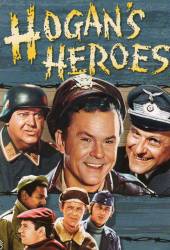Visible crew/equipment: When Le Beau signals the plane, the camera crew is reflected in the flashlight.
The Battle of Stalag 13 - S2-E5
Visible crew/equipment: As first Feldkamp, then von Kattenhorn, get in their respective staff cars, the camera crew and equipment is reflected on the doors and glass.
A Klink, a Bomb and a Short Fuse - S2-E8
Visible crew/equipment: As Burkhalter and Klink walk toward the office, the shadows of the crew, camera and lighting appear on camera.
A Klink, a Bomb and a Short Fuse - S2-E8
Visible crew/equipment: When Burkhalter gets out and goes toward the office, as the camera pans to follow, you can see the shadows of the film crew and equipment.
Visible crew/equipment: As the General gets in his staff car and it leaves, the film crew and equipment are reflected on the sides.
Visible crew/equipment: After Hogan, Le Beau and Schultz get into the car, and as it starts to move, chairs, people and equipment are reflected on the glass.






Answer: It's a comedy, not a documentary.
stiiggy
Perhaps it was counterfeit. There are numerous episodes where they deal in counterfeit monies.